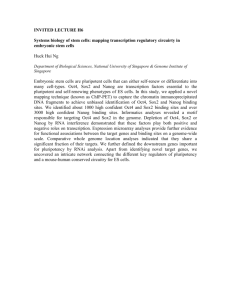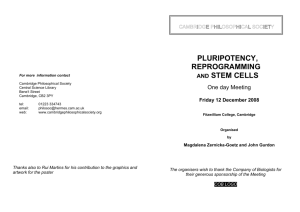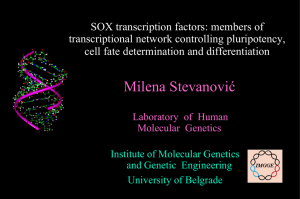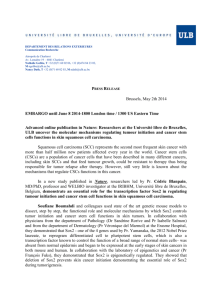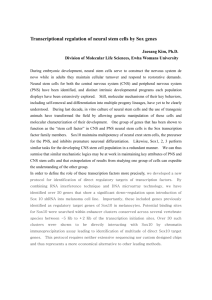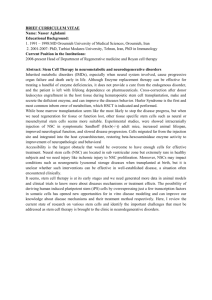How Sox2 maintains neural stem cell identity
advertisement
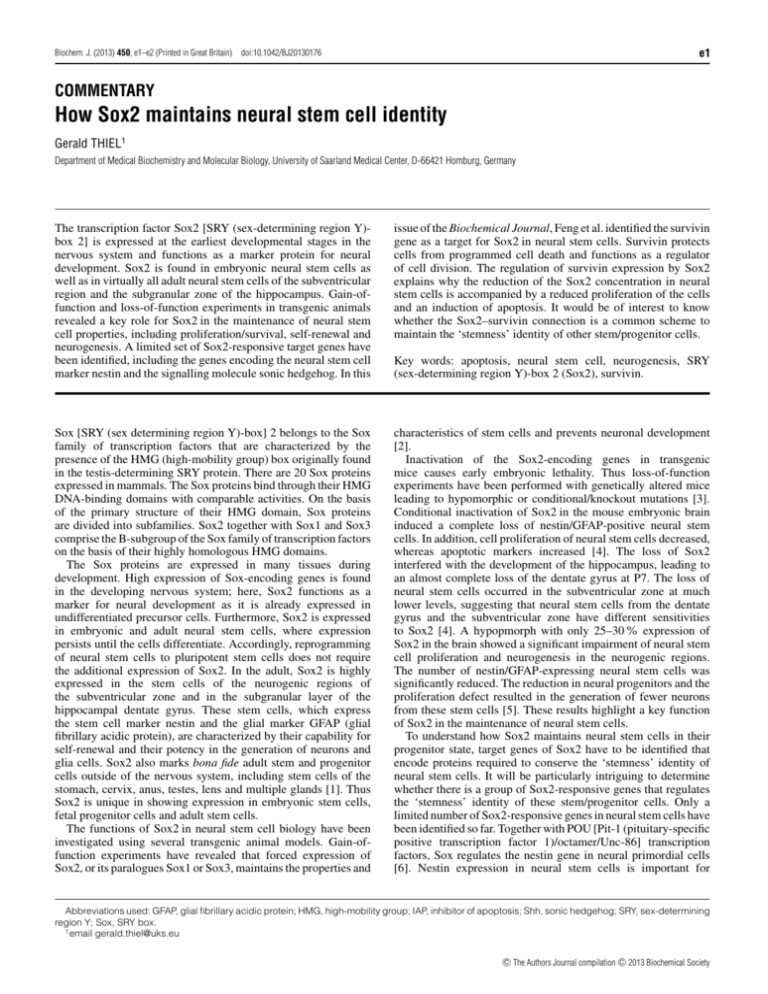
Biochem. J. (2013) 450, e1–e2 (Printed in Great Britain) e1 doi:10.1042/BJ20130176 COMMENTARY How Sox2 maintains neural stem cell identity Gerald THIEL1 Department of Medical Biochemistry and Molecular Biology, University of Saarland Medical Center, D-66421 Homburg, Germany The transcription factor Sox2 [SRY (sex-determining region Y)box 2] is expressed at the earliest developmental stages in the nervous system and functions as a marker protein for neural development. Sox2 is found in embryonic neural stem cells as well as in virtually all adult neural stem cells of the subventricular region and the subgranular zone of the hippocampus. Gain-offunction and loss-of-function experiments in transgenic animals revealed a key role for Sox2 in the maintenance of neural stem cell properties, including proliferation/survival, self-renewal and neurogenesis. A limited set of Sox2-responsive target genes have been identified, including the genes encoding the neural stem cell marker nestin and the signalling molecule sonic hedgehog. In this issue of the Biochemical Journal, Feng et al. identified the survivin gene as a target for Sox2 in neural stem cells. Survivin protects cells from programmed cell death and functions as a regulator of cell division. The regulation of survivin expression by Sox2 explains why the reduction of the Sox2 concentration in neural stem cells is accompanied by a reduced proliferation of the cells and an induction of apoptosis. It would be of interest to know whether the Sox2–survivin connection is a common scheme to maintain the ‘stemness’ identity of other stem/progenitor cells. Sox [SRY (sex determining region Y)-box] 2 belongs to the Sox family of transcription factors that are characterized by the presence of the HMG (high-mobility group) box originally found in the testis-determining SRY protein. There are 20 Sox proteins expressed in mammals. The Sox proteins bind through their HMG DNA-binding domains with comparable activities. On the basis of the primary structure of their HMG domain, Sox proteins are divided into subfamilies. Sox2 together with Sox1 and Sox3 comprise the B-subgroup of the Sox family of transcription factors on the basis of their highly homologous HMG domains. The Sox proteins are expressed in many tissues during development. High expression of Sox-encoding genes is found in the developing nervous system; here, Sox2 functions as a marker for neural development as it is already expressed in undifferentiated precursor cells. Furthermore, Sox2 is expressed in embryonic and adult neural stem cells, where expression persists until the cells differentiate. Accordingly, reprogramming of neural stem cells to pluripotent stem cells does not require the additional expression of Sox2. In the adult, Sox2 is highly expressed in the stem cells of the neurogenic regions of the subventricular zone and in the subgranular layer of the hippocampal dentate gyrus. These stem cells, which express the stem cell marker nestin and the glial marker GFAP (glial fibrillary acidic protein), are characterized by their capability for self-renewal and their potency in the generation of neurons and glia cells. Sox2 also marks bona fide adult stem and progenitor cells outside of the nervous system, including stem cells of the stomach, cervix, anus, testes, lens and multiple glands [1]. Thus Sox2 is unique in showing expression in embryonic stem cells, fetal progenitor cells and adult stem cells. The functions of Sox2 in neural stem cell biology have been investigated using several transgenic animal models. Gain-offunction experiments have revealed that forced expression of Sox2, or its paralogues Sox1 or Sox3, maintains the properties and characteristics of stem cells and prevents neuronal development [2]. Inactivation of the Sox2-encoding genes in transgenic mice causes early embryonic lethality. Thus loss-of-function experiments have been performed with genetically altered mice leading to hypomorphic or conditional/knockout mutations [3]. Conditional inactivation of Sox2 in the mouse embryonic brain induced a complete loss of nestin/GFAP-positive neural stem cells. In addition, cell proliferation of neural stem cells decreased, whereas apoptotic markers increased [4]. The loss of Sox2 interfered with the development of the hippocampus, leading to an almost complete loss of the dentate gyrus at P7. The loss of neural stem cells occurred in the subventricular zone at much lower levels, suggesting that neural stem cells from the dentate gyrus and the subventricular zone have different sensitivities to Sox2 [4]. A hypopmorph with only 25–30 % expression of Sox2 in the brain showed a significant impairment of neural stem cell proliferation and neurogenesis in the neurogenic regions. The number of nestin/GFAP-expressing neural stem cells was significantly reduced. The reduction in neural progenitors and the proliferation defect resulted in the generation of fewer neurons from these stem cells [5]. These results highlight a key function of Sox2 in the maintenance of neural stem cells. To understand how Sox2 maintains neural stem cells in their progenitor state, target genes of Sox2 have to be identified that encode proteins required to conserve the ‘stemness’ identity of neural stem cells. It will be particularly intriguing to determine whether there is a group of Sox2-responsive genes that regulates the ‘stemness’ identity of these stem/progenitor cells. Only a limited number of Sox2-responsive genes in neural stem cells have been identified so far. Together with POU [Pit-1 (pituitary-specific positive transcription factor 1)/octamer/Unc-86] transcription factors, Sox regulates the nestin gene in neural primordial cells [6]. Nestin expression in neural stem cells is important for Key words: apoptosis, neural stem cell, neurogenesis, SRY (sex-determining region Y)-box 2 (Sox2), survivin. Abbreviations used: GFAP, glial fibrillary acidic protein; HMG, high-mobility group; IAP, inhibitor of apoptosis; Shh, sonic hedgehog; SRY, sex-determining region Y; Sox, SRY box. 1 email gerald.thiel@uks.eu c The Authors Journal compilation c 2013 Biochemical Society e2 G. Thiel guaranteeing a proper self-renewal of neural stem cells [7]. Sox2 binds to the gene encoding Shh (sonic hedgehog) in neural stem cells. Shh is required for the normal growth of neural stem cells in vitro and functions as a potent mitogen for neural progenitor cells in the brain. Loss of Sox2 is accompanied by a loss of Shh in the hippocampal primordium. This Sox2–Shh connection was corroborated by pharmacological and genetic rescue experiments in vivo and in vitro [4], suggesting that reduced Shh activity is, at least in part, responsible for the hippocampal neural stem cell defects in Sox2-deficient mice. In this issue of the Biochemical Journal, Feng et al. [8] present data showing that Sox2 activates expression of the survivin gene in neural stem cells. Survivin, a member of the IAP (inhibitor of apoptosis) family of proteins, prevents programmed cell death via co-operative interaction with XIAP (X-linked IAP), another IAP protein. In addition, survivin functions as a regulator of cell division. Accordingly, conditional deletion of survivin results in mitotic defects and cell death [9]. Feng et al. [8] showed that overexpression of Sox2 increased survivin expression, whereas knockdown of Sox2 led to decreased survivin concentration in the cells and an induction of programmed cell death. Furthermore, forced expression of survivin protected neural stem cells from the programmed cell death normally induced by the knockdown of Sox2. These data were corroborated in vivo by in utero injection of Sox2-specific small hairpin RNA in the presence or absence of a survivin expression vector into the lateral ventricle of the mouse brain at E14.5 (embryonic day 14.5). The results provide an explanation for the observation that in Sox2 hypomorphic mice reduced levels of Sox2 result in proliferation defects and an up-regulation of apoptosis in neural stem cells. Thus the up-regulation of survivin expression by Sox2 contributes to the maintenance of the ‘stemness’ identity of neural stem cells by supporting the survival of the cells. In concert with other Sox2 target genes, such as the genes encoding nestin or Shh as well as other not yet identified genes, the identity of neural stem cells is preserved. Sox2 regulates important functions not only in neural stem cells of the CNS (central nervous system), but also in a variety of other tissue-specific stem/progenitor cells [1]. It will be important to elucidate whether Sox2 regulates a common set of genes in these cells to promote the self-renewal potential and to inhibit apoptosis or differentiation. However, the fact that Sox2 function is dose- and context-dependent argues for a stem cell-type specific set of Sox2 target genes that maintain the properties of these cells. This is illustrated by the observations that Sox2 plays a key role in the regulation of the Notch pathway in retinal progenitor cells, whereas only marginal effects on the Notch pathway were observed in the hippocampal neural stem cells expressing reduced Received 1 February 2013; accepted 4 February 2013 Published on the Internet 28 February 2013, doi:10.1042/BJ20130176 c The Authors Journal compilation c 2013 Biochemical Society levels of Sox2 [4,10]. Thus Sox target genes may differ depending upon the stem cell type and the period of development. In addition, the chromatin architecture of Sox2 target genes may be different in various tissue-specific stem/progenitor cells. The expression of the survivin gene has recently been shown to depend on the activity of chromatin-modifying proteins such as Bmi1 (BMI1 polycomb ring finger oncogene), a component of the polycomb repressive complex 1 [11]. These results highlight the necessity of analysing both the expression of Sox2 target genes in different types of stem cells and the chromatin structure of these target genes. Sox2 will stay in the limelight and the sum of Sox2 target genes will certainly explain the ‘stemness’ character in molecular terms. REFERENCES 1 Arnold, K., Sarkar, A., Yram, M. A., Polo, J. M., Bronson, R., Sengupta, S., Seandel, M., Geijsen, N. and Hochedlinger, K. (2011) Sox2 + adult stem and progenitor cells are important for tisue regeneration and survival of mice. Cell Stem Cell 9, 317–329 2 Bylund, M., Andersson, E., Novitch, B. G. and Muhr, J. (2003) Vertebrate neurogenesis is counteracted by Sox1–3 activity. Nat. Neurosci. 6, 1162–1168 3 Pevny, L. H. and Nicolis, S. K. (2010) Sox2 roles in neural stem cells. Int. J. Biochem. Cell Biol. 42, 421–424 4 Favaro, R., Valotta, M., Ferri, A. L. M., Latorre, E., Mariani, J., Giachino, C., Lancini, C., Tosetti, V., Ottolenghi, S., Taylor, V. and Nicolis, S. K. (2009) Hippocampal development and neural stem cell maintenance require Sox2-dependent regulation of Shh. Nat. Neurosci. 12, 1248–1256 5 Ferri, A. L. M., Cavallaro, M., Braida, D., Di Christofano, A., Canta, A., Vezzani, A., Ottolenghi, S., Pandolfi, P. P., Sala, M., DeBiasi, S. and Nicolis, S. K. (2004) Sox2 deficiency causes neurodegeneration and impaired neurogenesis in the adult mouse brain. Development 131, 3805–3819 6 Tanaka, S., Kamachi, Y., Tanouchi, A., Hamada, H., Jing, N. and Kondoh, H. (2004) Interplay of SOX and POU factors in regulation of the nestin gene in neural primordial cells. Mol. Cell. Biol. 24, 8834–8846 7 Park, D., Xiang, A. P., Mao, F. F., Zhang, L., Di, C.-G., Liu, X.-M., Shao, Y., Ma, B.-F., Lee, J. H., Ha, K.-S. et al. (2010) Nestin is required for the proper self-renewal of neural stem cells. Stem Cells 28, 2162–2171 8 Feng, R., Zhou, S., Liu, Y., Song, D., Luan, Z., Dai, X., Li, Y., Tang, N., Wen, J. and Li, L. (2013) Sox2 protects neural stem cells from apoptosis via up-regulating survivin expression. Biochem. J. 450, 459–468 9 Altieri, D. C. (2010) Survivin and IAP proteins in cell death mechanisms. Biochem J. 430, 199–205 10 Taranova, O. V., Magness, S. T., Fagan, B. M., Wu, Y., Surzenko, N., Hutton, S. R. and Pevny, L. H. (2006) SOX2 is a dose-dependent regulator of retinal neural progenitor competence. Genes Dev. 20, 1187–1202 11 Acquati, S., Greco, A., Licastro, D., Bhagat, H., Ceric, D., Rossini, Z., Grieve, J., Shaked-Rabi, M., Henriquez, N. V., Brandner, S. et al. (2013) Epigenetic regulation of survivin by Bmi1 is cell type specific during corticogenesis and in gliomas. Stem Cells 31, 190–202
